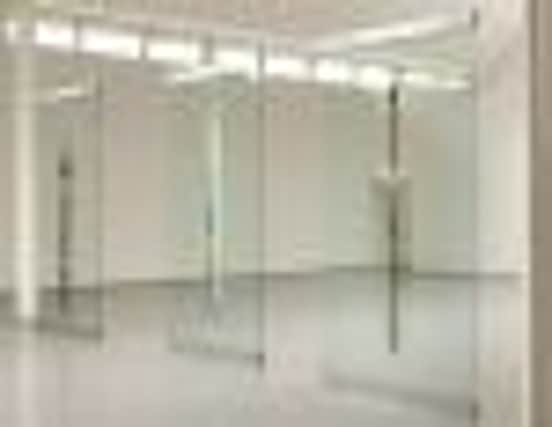Jutta Koether creates a modern incarnation of a classic at DCA


On the other, Nicolas Poussin, the scholarly 17th-century painter whose classical paintings have been loved for their rigour by the most uptight figures in the history of art from the French revolutionary Jacques-Louis David to the painstaking modernist Cézanne.
The connection is that, in the summer of 2008, Dundee Contemporary Arts curator Graham Domke took Koether to visit the National Galleries of Scotland, and the artist was blown away by Poussin’s The Seven Sacraments, on long-term loan to the gallery as part of the Bridgewater Collection.
Advertisement
Hide AdThe Seven Sacraments are amongst the most important works of 17th century art, so good that Poussin painted the subject twice. It is the second and only complete surviving set, painted between 1644 and 1648, that hangs in Edinburgh.
Their deep religious symbolism might be a lost language in a secular age, but a number of things still stand out: the paintings have an incredible theatrical intensity, they use still vivid and sometimes shocking colour and their elaborate construction means that each artwork feels like a painstakingly hand-built machine, every tiny cog necessary to make the whole thing whirr.
That summer, Koether had taken part in Altered States of Paint, a major group show featuring a dark psychedelic trend in recent painting. Domke had recently joined the gallery, and at the time, I wondered aloud to what extent his show would establish a new set of interests at the venue.
Some five years later, it’s clear that Altered States did confirm a new network of relationships which are steadily bearing fruit. Jutta Koether: Seasons and Sacraments is a major solo exhibition from an artist who, since the 1980s, has been steadily moving from the heart of the cultural underground to the centre of the art world and debates about the future of painting. And it has Koether’s lightbulb moment in Edinburgh at its heart.
The show begins with a tribute to another Poussin series, The Four Seasons. In Koether’s The Seasons, four canvases are hung on plates of glass, sometimes back to back; they require the visitor to engage in an awkward little dance. Each is a fractured landscape in which figures frolic across a scruffy white ground. Hung on windows, they play with the notion of painting as a window on the world. There are vivid pencil marks, little simulations of the mechanics of painting including framing devices. Nails and tacks and the L-shaped plates that hold frames together are drawn in pencil.
The Four Seasons were Poussin’s final works, about the ages of man as much as the turn of the year. Koether’s four paintings introduce a modern iconography. For emblematic youth she uses images of the racing driver Sebastian Vettel, a world celebrity and a national hero in her native Germany (she lives between Berlin and New York and is a professor in Hamburg.) At 25, Vettel is, of course, startlingly youthful to be world champ. The image of a young, handsome man taking part in a death-defying sport, while splattered with garish brand names like Total and Infiniti, is both ridiculous and poignant. For Poussin, death stalked every summer garden, and every spring led inexorably to punishing winter. Much of his life was plagued with illness; scholars now think it was venereal disease. Pleasure is short-lived, but suffering endures.
Advertisement
Hide AdThere is something of that darkness in Koether’s own versions of the Seven Sacraments of the Catholic Church. Extreme Unction, the practice of anointing the sick with oil, is interpreted as a pile of black painted planks, like a broken body, which has been coated with poured clear acrylic.
There is an analogy between painting and touch, a hint of the mysterious necessity of religious rites and artefacts. It is dressed in the everyday and mundane, cheap jewellery scattered amongst the woodwork, ordinary words made magical as they are scrawled on the painted surfaces.
Advertisement
Hide AdPenance is a quiet corner, a Danish clear Perspex table that apes the form of flowing fabric that Koether has filled with trashy artefacts. Modern prayer seems garish and commercial.
Ordination is a coil of LED rope lights. Confirmation is most impressive – three vast double-sided glass panels each sandwiching torn canvas strips, poured acrylic, a chaotic jumble of keys and feathers. There are drawing pins like tiny mirrors, the electronic id cards that these days act as keys.
The Eucharist brings us back to Poussin’s works – digital versions displayed on a suspended screen. They are the holiest of holies, religious artefacts in our earnest but sometimes misplaced worship of ancient art.
There are parts of me that feel deeply uncomfortable with some of these works. The Seasons in particular feels dry and intellectual. I’m not sure why painting needs to battle for its relevance.
But in the works where the border between painting and performance are blurred, where the motions of the sacraments are reflected in the flow of contemporary materials like crystal, acrylic and glass, and where you sense the presence and movement of the artist herself, the show is very strong. Where Koether abandons that struggle to give new life to old forms and gives in wholeheartedly to her more experimental nature, painting seems very much alive on its own terms.
Jutta Koether: Seasons and Sacraments, Dundee Contemporary Arts until 21 April. www.dca.org.uk
Twitter: @moirajeffrey